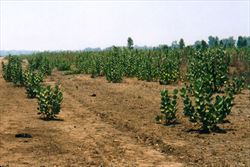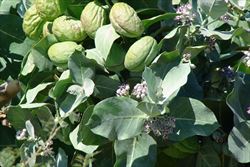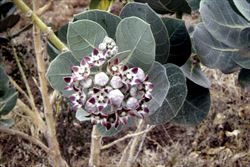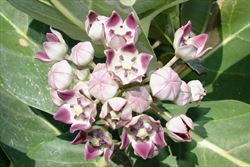Click on images to enlarge

infestation (Photo: Land Protection, QDNRW)

habit (Photo: Forest and Kim Starr, USGS)

habit (Photo: Forest and Kim Starr, USGS)

leaves and flower clusters (Photo: Land Protection, QDNRW)

young leaves (Photo: Sheldon Navie)

leaf undersides and flower clusters (Photo: Forest and Kim Starr, USGS)

flowers and flower buds (Photo: Forest and Kim Starr, USGS)

close-up of flower (Photo: Forest and Kim Starr, USGS)

immature fruit (Photo: Forest and Kim Starr, USGS)

close-up of immature fruit (Photo: Land Protection, QDNRW)

mature fruit with seeds (Photo: Forest and Kim Starr, USGS)

close-up of seeds with hairs removed (Photo: Steve Hurst at USDA PLANTS Database)
Scientific Name
Calotropis procera (Ait.) Ait.
Synonyms
Asclepias procera Ait.Calotropis procera (L.) Dryand.Calotropis procera (Willd.) R. Br.
Family
Asclepiadaceae (the ACT, Victoria, Tasmania, South Australia, Western Australia and the Northern Territory)Apocynaceae (Queensland and New South Wales)
Common Names
apple of Sodom, auricula tree, cabbage tree, calotrope, calotropis, Dead Sea apple, giant milkweed, Indian milkweed, kapok tree, King Edward's crown, king's crown, king's crown kapok, Prince of Wales' crown, rubber bush, rubber plant, rubber tree, rubberbush, small crown flower, small crownflower, Sodom apple, Sodom's milkweed, swallowwort
Origin
Native to northern Africa (i.e. Algeria, Egypt, Libya, Morocco, Eritrea, Ethiopia, Somalia, Sudan, Kenya, Tanzania, Uganda, Cameroon, Equatorial Guinea, Gambia, Ghana, Guinea-Bissau, Mauritania, Nigeria, Senegal and Sierra Leone), the Arabian Peninsula (i.e. Saudi Arabia, Oman and Yemen), the Middle East, and southern Asia (i.e. Afghanistan, Pakistan, Nepal, India, Myanmar, Thailand and Vietnam).
Cultivation
This species was cultivated as a garden plant (i.e. ornamental) in the past, but it is now out of favour because it is poisonous and generally regarded as a weed.
Naturalised Distribution
This species is widespread in the drier northern parts of Australia. It is mostly found in northern Queensland, north-western Western Australia and in the northern parts of the Northern Territory. Also present in other parts of the Northern Territory, and recorded in South Australia and New South Wales.
It has also become naturalised in parts of Central America, northern South America, the Caribbean, south-western USA (i.e. California) and in Hawaii.
Habitat
Found mostly in semi-arid and arid inland areas, as well as in the drier parts of tropical and sub-tropical regions. A weed of disturbed sites, roadsides, waste areas, near inland watercourses, coastal sand dunes, grasslands, open woodlands and pastures.
Habit
An upright (i.e. erect) shrub or small tree usually growing 1-4 m tall.
Distinguishing Features
- a large shrub with waxy stems and leaves that contain a milky sap.
- its relatively large greyish-green leaves (5-20 cm long and 4-10 cm wide) are borne in pairs and are stem-clasping.
- its flowers (20-30 mm across) have five petals that are white with purplish-coloured tips and a purplish crown-like centre.
- its fruit is a large (8-12 cm long) bladdery 'pod' that is greyish-green in colour.
- this fruit splits open at maturity to release numerous seeds, each topped with a tuft of long, white, silky hairs.
Stems and Leaves
The stems and leaves have a waxy appearance and contain a milky white sap (i.e. latex). Branching occurs from the base of the plant upwards. Younger stems are greyish-green in colour, smooth in texture, and have a covering of whitish coloured hairs (i.e. they are hoary). Mature stems have a deeply fissured, cork-like, bark that is light brown in colour.
The large, relatively thick, leaves (5-30 cm long and 4-15 cm wide) are also greyish-green in colour and have entire margins. They are oppositely arranged and have stem-clasping bases (i.e. they are sessile) or very short stalks (i.e. petioles) 3-4 mm long. These leaves are rounded (i.e. orbicular) or egg-shaped in outline (i.e. ovate) with shortly-pointed tips (i.e. acute apices). Their upper surfaces are mostly hairless (i.e. glabrous), while their undersides may be densely covered in tiny white hairs or have a tuft of stiff hairs at the base of the central vein (i.e. midrib).
Flowers and Fruit
The flowers (15-25 mm across) are borne in clusters, each containing 3-15 flowers, in the forks of the uppermost leaves (i.e. in axillary inflorescences). The main stalk of these flower clusters (i.e. peduncle) is 20-55 mm long and each flower has a stalk (i.e. pedicel) about 15-25 mm long. These flowers have five spreading petals (7-10 mm long and 6-10 mm wide) that are white or pinkish in colour, with much darker purple or purplish-brown tips, and a crown-like centre (i.e. corona) that is also purplish in colour. They also have five sepals (about 5 mm long and 3 mm wide) that are oval (i.e. elliptic) or egg-shaped in outline (i.e. ovate) and five stamens. Flowering occurs mostly during winter.
The fruit is a large (6-12 cm long and 3-7 cm wide) bladdery 'pod' (i.e. follicle) that is greyish-green in colour and rounded (i.e. sub-globose) to somewhat egg-shaped (i.e. obliquely ovoid). These fruit have thick and spongy skins which split open at maturity. Each fruit contains numerous brown, flattened seeds (about 6 mm long and 4 mm wide) that are topped with a tuft (i.e. coma) of long, white, silky hairs (35-50 mm long).
Reproduction and Dispersal
This plant reproduces mainly by seeds, though local increase in the size and density of populations also occurs via suckering from the roots.
The seeds can be spread long distances by wind and water and can also be dispersed in mud that becomes attached to animals and vehicles.
Environmental Impact
Calotrope (Calotropis procera) is regarded as an environmental weed in the Northern Territory, Western Australia and Queensland. It thrives on poor soils, particularly where overgrazing has removed competition from native grasses, and forms dense thickets which compete with native plant species and transform the appearance of savanna plant communities. This species is culrrently listed as a priority environmental weed in three Natural Resource Management Regions and it is being actively managed by community groups in the Northern Territory.
Other Impacts
The milky sap is toxic to humans and sometimes also to livestock. It can also hinder pastoralism by reducing the productivity of rangeland pastures and making mustering more difficult.
Legislation
This species is declared under legislation in the following states and territories:
- Northern Territory: B - spread to be controlled (only south of 16°30'S latitude), and C - not to be introduced into the Territory.
- Western Australia: P1 - trade, sale or movement into the state prevented (in all districts north of the 26th parallel of latitude, except the Ashburton, Broome, Derby-West Kimberley, East Pilbara, Halls Creek, Port Hedland, Roebourne and Wyndham-East Kimberley local authority areas), and P2 - to be eradicated (in the Ashburton, East Pilbara, Port Hedland and Roebourne local authority areas).
Management
For information on the management of this species see the following resources:
- the Biosecurity Queensland Fact Sheet on this species, which is available online at http://www.dpi.qld.gov.au.
- the Northern Territory Department of Natural Resources, Environment and The Arts Agnote on this species, which is available online at http://www.nt.gov.au/weeds.
Similar Species
Calotrope (Calotropis procera) is very similar to giant calotrope (Calotropis gigantea). These two species can be distinguished by the following differences:
- calotrope (Calotropis procera) is a large shrub growing 1-4 m tall. Its flowers are slightly cup-shaped in appearance and their relatively short and broad petals are whitish with purple tips.
- giant calotrope (Calotropis gigantea) is a large shrub or small tree often growing more than 4.5 m tall. Its flowers have relatively long and narrow petals that are bent outwards and are uniformly pink or mauve in colour (or have only slightly darker tips).

